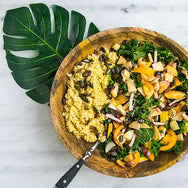Words by Linia Patel
It’s hard not to be sucked in by the idea that a “detox” or a “cleanse” can wash away your caloric sins, flush your system of impurities and leave your organs squeaky clean and rearing to go. Before you dust off your juicer it’s important to explore the idea behind the need to rid our body of toxins. Doesn’t the body have its own defences that naturally cleanse our systems? Does science support the use of detox diets?
HISTORY OF DETOX DIETS
The concept of cleansing the body of built-up toxins is not new. In fact, detoxifying practices have been around for centuries. Historically, many detoxification diets were based on religious beliefs and typically involved fasting. Many historians attribute detoxification diets to Ayurveda. As far back as 400 bc, ancient Ayurvedic medicine practitioners frequently recommended diets that cleansed the body of impurities by eliminating various food groups and emphasising a plant-based diet. Sweating has also been thought of as an effective form of detoxification. European spas became world famous more than 2,000 years ago. The natural springs of these legendary spas like Epsom were believed to cure everything from acne to arthritis.
Today, a diet is classified as “detox” if it involves making a change to one’s eating patterns with the goal of ridding the body of accumulated toxins. Detoxification diets vary, but they usually involve fasting, avoidance of many food groups and/or consumption of cleansing beverages. The two most common types of detox diets are liquid plans and those that start with liquids and then progress to solid foods. Detox diets also vary in duration but typically last from 3 days to about a month.
THE TRUTH ABOUT TOXINS
A toxin is a chemical or poison that is known to have harmful effects on the body. The list of toxins contains hundreds of names – the most popular among toxins them being lead we once found in our water systems, the mercury we find in fish, bisphenol A or BPA found in consumer plastics and pesticides, and the azodicarbonamide we find in yoga mats. However the word “toxin” has been hammered so flat and broad that is has actually become meaningless. The toxin your favourite celebrity health expert is talking about seem to come from food.
Too often, the word toxin gets confused with free radicals for example. The words are as familiar as they are misunderstood. Free radicals occur naturally within the body. They are produced as a consequence of your body constantly reacting with oxygen as you breathe and through cellular metabolism. Free radicals interact with membranes, proteins and the DNA within cells to cause oxidative damage. Oxidative damage has been implicated in the cause of many diseases, such as cancer and Alzheimer's and has an impact on the body's aging process. To counteract oxidative stress, the body produces an armory of antioxidants to defend itself. The role of these antioxidants is to neutralise or 'mop up' free radicals that can harm our cells. Your body's ability to produce antioxidants is controlled by your genetic makeup and influenced by your exposure to environmental factors, such as diet and smoking.
The basic idea behind a 'detox diet or regimen' is that the modern world puts so much stress on our bodies as we are exposed to a large number of “toxins” on a daily basis. Detox plans also claim that the natural detoxification mechanisms in place in our bodies cannot keep up the detox demands. Therefore, 'active detox' is a good idea.

BUILT IN DETOX SYSTEM
The scientific definition of detoxification is the biochemical process that transforms non-water-soluble toxins and metabolites into water-soluble compounds that can be excreted in urine, bile or stool.
Your body is actually an efficient detox machine. The skin – your body’s largest organ provides a barrier to harmful substances. Your airways trap and expel harmful substances and chemicals from pollution, while your intestine’s screen out harmful organisms while allowing nutrients to be absorbed into the blood. The kidney excretes waste products into the urine – otherwise the substance stays in the blood. However the main organ involved in the detoxification process is the liver.
The liver plays several roles in detoxification: it filters the blood to remove toxins ( such as alcohol, drugs and insecticides), gets rid of bile and other fat-soluble toxins and eliminates unwanted chemicals. The enzymatic process to dispose of toxins occurs in two enzymatic phases: phase I and phase II detoxification.
WHAT DOES THE EVIDENCE SAY?
There are no shortages of glowing testimonials from people who have gone on detox diets claiming to feel cleansed, energised and healthier. The literature recognises that the detoxification systems in humans is highly complex and is influenced by a number of regulatory systems, have individual uniqueness and are responsive to an individual’s environment and lifestyle. However there’s no published evidence to suggest that detox treatments, kits or rituals have any effect on our body’s ability to eliminate waste products effectively.
Research on using specific foods in clinical practice to aid detoxification still is in its infancy; however there have been some interesting studies worth noting. For example lab based studies have shown that two compounds found in cruciferous vegetables (indole 3-carbinol and crambene) activate detoxification enzymes. The phytochemicals in these vegetables have also been shown to reduce oxidative stress which is key in preventing damage to cells and the DNA caused by the production of free radicals in phase I detoxification. In a recent study, 20 participants were encouraged to eat 1 to 2 cups of cruciferous vegetables a day. After three weeks, the amount of oxidative stress in their body was measured. Then, after a three-week wash-out period, the study participants were told to take a multivitamin with fibre. Again, the oxidative stress was measured three weeks later. The results showed that oxidative stress in the subjects' bodies dropped 22% during the period when they were eating lots of cruciferous vegetables. But the change during the multivitamin segment was negligible (0.2%).
Several factors influence how much of a chemical ends up in the system requiring detoxification by the liver. The gut initially provides a physical barrier to external toxins, but is also the second major site in the body for detoxification. Detoxification enzymes are found in high concentrations in the villi of the intestines. There is also evidence that links poor gut health to an increased toxic load. Good gut bacteria can produce compounds that either inhibit or induce detoxification activities. Bad bacteria can also produce toxins that can enter circulation and increase toxic load.

CLEAN EATING AND DETOX
You can actually “cleanse” by eating healthier and being more active. Here are five top tips:
- Stay hydrated. The importance of adequate hydration for detoxification cannot be underestimated. Water facilitates urinary excretion and bowel motility, supports the lymphatic system and replenishes fluid through sweat. Green tea is rich in polyphenols which are known for their antioxidant activity, so is a good hot drink choice.
- Look after your gut bacteria. Beneficial bacteria from fermented foods such as yogurt and lacto-fermented vegetables or from supplements inhibit the growth of “bad” bacteria, which produce ammonia and other “toxic” metabolites.
- Eat 5-a-day or more. A diet high in fruit and vegetables contributes to a wide range of phytochemicals and antioxidants. Include one portion of cruciferous vegetables such as cabbage, broccoli, collards, kale and brussel sprouts in your diet as this will promote the activity of enzymes that regulate detoxification in the liver.
- Stock up on foods containing sulphur. Sulphur supports the body’s production of glutathione – a powerful antioxidant. Include foods like eggs, nuts, legumes, garlic, onion and leeks in your diet.
- Fill up on fibre. Soluble and insoluble fibre as found in flax seeds, beans, oats and brown rice can bind to metabolic waste in the gut, carrying them out of the body through the stool. It can also minimise contact with harmful compounds such as acylamides from charred meat by regulating transit time.
TAKE HOME MESSAGE
While some detox programmes encourage some positive habits like drinking more water, reducing alcohol consumption, and eating more fruit and vegetables the truth is that an active lifestyle and healthy balanced and varied diet is the best detox diet out there. There are well-designed body mechanisms for detoxification and the maintenance of homeostasis. Good nutrition, rich in essential nutrients, helps to ensure a healthy, properly functioning detoxification system.
References
- Mahan, L.K., & Escott-Stump, S. 2007. Krause’s Food & Nutrition Therapy, 12th ed. Saunders.
- Schaeffer, J. 2008. Spring cleansing: Assessing the benefits and risks of detox diets. Today’s Dietitian, 10 (5), 34.
- Jeffer E. 2007. Diet and detoxification enzymes. The Proceedings from the 13th International Symposium if the Institute for Functional Medicine, Managing Biotransformation; The Metabolic Genomic, and Detoxification Balance Points. Altern Ther Health Med. 13 (2);598-S99
- Genius S. 2011. Elimination of persistent toxicants from the human body. Hum Exp Toxicol 30 (1): 3 – 18
- Liska D.1998. The detoxification enzyme systems. Altern Med Rev. 1998; 3(3); 187 – 198
- Percival M. 1997. Phytonutrients & Detoxification. Clinical Nutrition Insights. Volume 5. No 2
- Moores, S. 2007. Experts warn of detox diet dangers. www.msnbc.msn.com/id/18595886;





























































